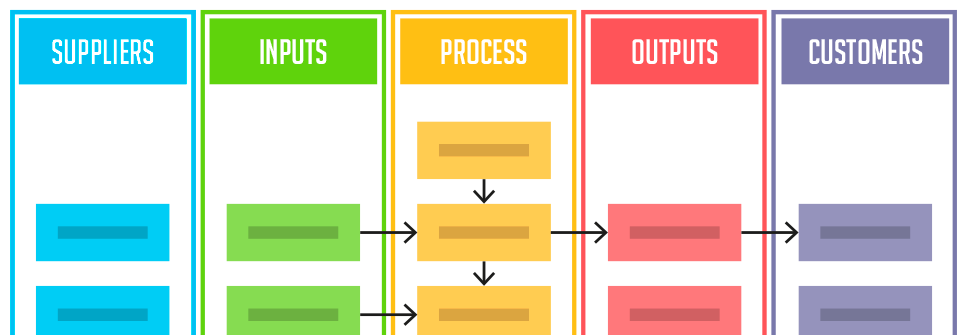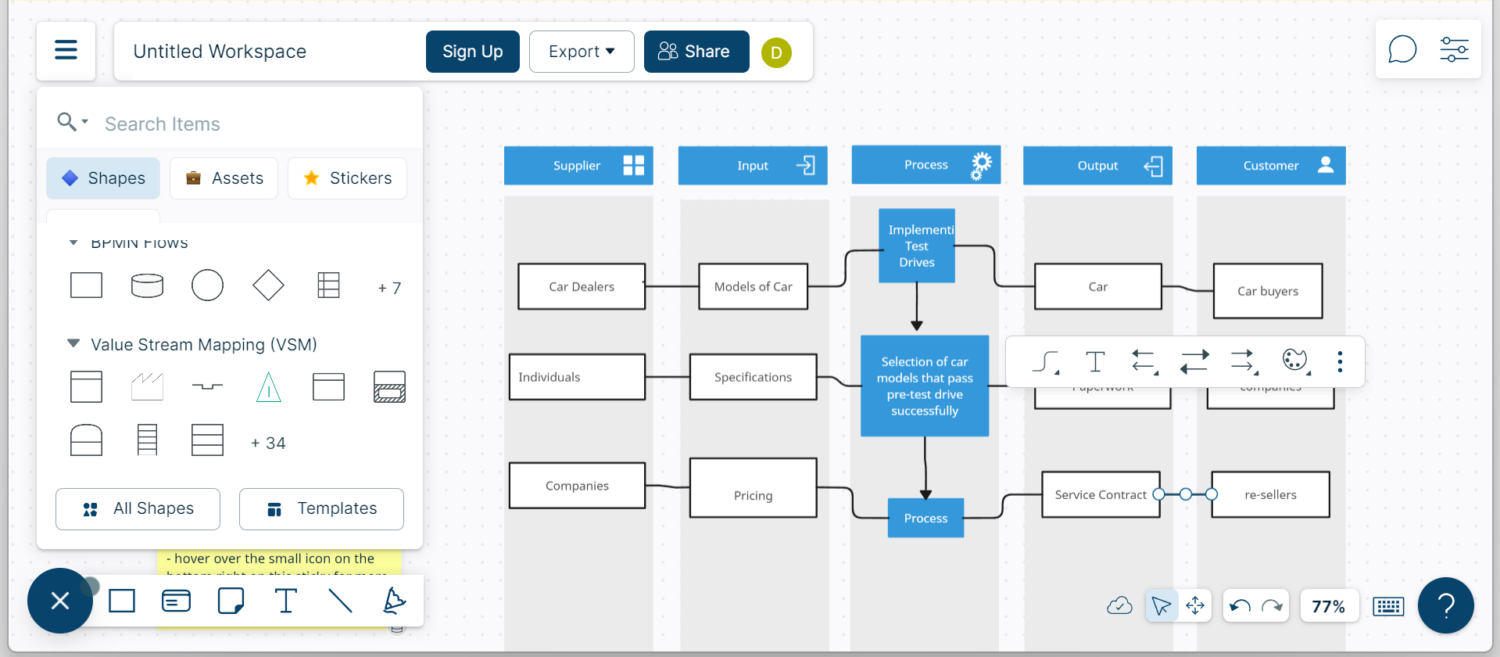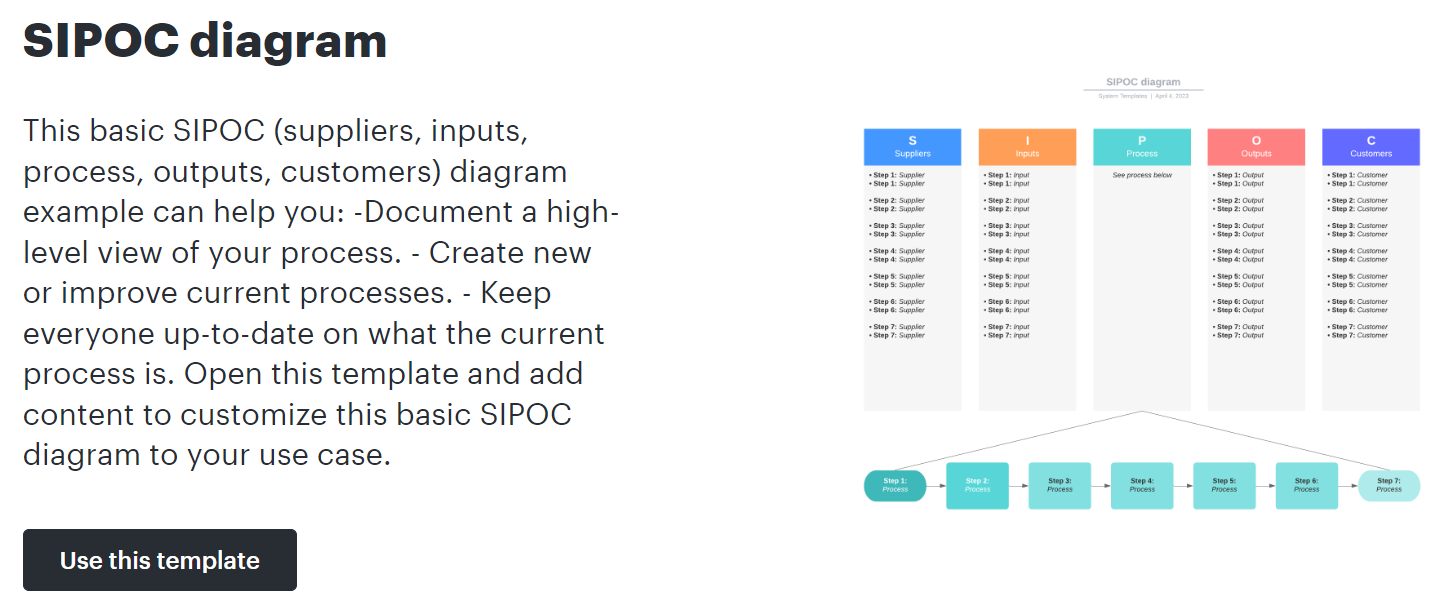In the realm of commercial spaces, firms come across complex projects that they need to execute with meticulous precision. For this purpose, it is vital to streamline operations so there’s no hotch-potch at the last moment.
Commercial spaces utilize visual tools for their seamless operations and project management. In the intricate web of workflows, one such visual tool is the SIPOC diagram. It provides clarity and strategic planning in the realm of Business Project Management.
Thus, if you strive to achieve operational excellence in an organization, leveraging its power helps. But what is a SIPOC tool, and how to create one?
SIPOC diagrams provide a bird’s eye view by recording how inputs will be transformed into actionable outcomes to achieve the desired outputs. Further, it also includes how customers will get these deliverables.
SIPOC stands for Suppliers, Inputs, Processes, Outputs, and Customers, which maps the entire Business Project Management cycle. It comprises steps that outline the process and illuminate its inner workings. This brief visual can also be imagined as a blueprint for a project.
Thus, your team can collaborate effectively in real-time for active problem-solving. For an organization, it’s no less than a compass that helps to know the direction in which you should proceed.
So, your efforts won’t be vague as you will have a strategic and structured approach to proceed. Let’s embark on the captivating journey of SIPOC diagrams and the easiest creation approaches!
What Does a SIPOC Diagram Comprise Of?

Now that you know what SIPOC diagrams you would be wondering what each of its elements means. Without any further ado, let’s dig into the details!
✔Suppliers: Every business or project needs resources that lead the project to completion. The suppliers part of the diagram deals with who provides the resources, including workforce, materials, investments, etc., required for the project.
✔Inputs: While the Supplier’s part tells who would act like your supplier for the project, the part of the input will contain what you need. These are raw materials, the exact finances, equipment, and similar.
✔Process: Process is the action plan to execute the project in a series of tasks.
✔Outputs: Outputs contain the project outcome that would be generated after the process ends. These include the deliverables like products and other tangible or intangible results.
✔Customers: These are the people who will receive the product or outcome of the project. The customers are usually internal stakeholders or clients.
Each of the key elements is defined to create a proper SIPOC Diagram.
What is the Role of a SIPOC Diagram?
A SIPOC Diagram is a core part of business project management (BPM). It is not essential for every project the company undertakes, but it simplifies the larger and more complex ones. Thus, it is a visual tool that helps improve the outcome.
It provides a brief understanding of who will provide the supplies, what is needed, how to execute the plan, the final results that will turn out, and when consumers will get the deliverables.
How Does SIPOC Diagram Help?
Many of you would think of SIPOC diagrams as unnecessary formalities and discuss the idea of preparing one. While you would have plenty of reasons why not to go for a SIPOC Diagram, we have several core reasons for how it would improve your business projects.

✔Helps to Save Costs: It is a blueprint of what you require for a project, including labor, cost, resources, and other things. You also get a list of the profits. The SIPOCs, as they map the whole project, it helps you to visualize what you need and what not. You can focus on areas where you can save money, thus making the project cost-effective.
✔Begins the Process Strategically: You would think that SIPOC Diagram isn’t a real-time entity, nor some of your clients would require so how it’s a process of the project.
Well, by creating the SIPOC diagram, you already start planning about the supplies, suppliers, which of the personnel would contribute, etc. Thus, with a strategic approach, the outcome would be better, resulting in an improved yield and avoiding last-minute hassle.
✔An Edge Over the Resources: By presenting a SIPOC Diagram in front of your team or personnel involved, more people get a sneak peek into it. Thus, multiple people can share their opinions, advice, and ideas which can be considered to execute things better and most often results in lesser use of resources.
Thus, the SIPOC Diagram is an essential part of project management which helps improve efficiency and thus increase projects.
Example of SIPOC Diagram
The basic idea of the SIPOC diagram is to understand the input and output of a process from its initiation to completion. In this example, we will discuss the Car purchase process.
Supplier: Car Dealers, Individuals, Companies.
Input: Model of Cars, Specifications, Pricing.
Process: Implementing Test Drive, Selection of car models that pass pre-test drive successfully, Process.
Output: Car, Paperwork, Service Contract.
Customer: Car buyers, Companies, Re-seller.

This simply describes the process followed and the steps taken care to come to the final output. With the help of the below-mentioned tools, you can make your own SIPOC diagram as per the requirement.
Lucidchart
Lucidchart is one of the most beginner-friendly visual tools making platforms. You can create SIPOC diagrams using the online tool or download its Android app. There’s a specific template that you can personalize as per your needs. However, before using the template, you must sign up or sign up with Google, Slack, or Microsoft 365.

Features
- You can add up to 60 shapes in a single diagram in the free plan and more in the paid plan.
- Can integrate with platforms like Jira, GitHub, Slack, and others and even import their data.
- Create better versions by comparing two documents as it highlights the differences.
- Real-time collaboration is more manageable with timestamp ordering, naming versions, and such access control features.
- Easy layout and well-organized GUI for quickly catching up.
No wonder Lucidchart is an excellent diagramming tool for creating SIPOC and more such diagrams. With the free version can use it for basic diagrams. For advancements, you need to upgrade to the pro version.
Visual Paradigm
Visual Paradigm, as the name suggests, helps you map the paradigms involved in any process. Thus, you can create any diagrams with it, and users have loved it for creating SIPOC diagrams. It has a decent range of 200 templates that you can customize for your project.

Features
- A vast range of inbuilt tools to conveniently create the desired SIPOC.
- Draw SIPOC diagrams as Visio Drawings, and import them into Visual Paradigm for real-time collaboration.
- It enables you to embed diagrams and integrate them into Word, PowerPoint, Outlook, and similar Microsoft Office platforms.
- Supports exporting SIPOC diagrams into PNG, JPG, PDF, SVG, and similar file formats.
What users love about the tool is that they don’t need hands-on training to use it because it’s beginner friendly. Moreover, there’s no limitation to the number of shapes, lines, or elements you can use. Thus, it is a comprehensive tool to make designing SIPOC diagrams easier.
Creately
Creately is another diagramming tool that aces well for collaboration. Its canvas has many features for you to customize SIPOC templates smartly. Previously known as a work management platform, it is number one due to its smart universal canvas. So, let’s embark on what makes it incredible!

Features
- Easy editing with an intuitive drag and drop feature.
- Enables you to give access controls to your team.
- Has an inbuilt voting feature for opinions on the tool.
- CMS Integrations let you save your diagrams over there or import data from them into the SIPOC diagrams.
- Contains an inbuilt screen-sharing option to cast diagrams in meetings.
You can use Creately templates both online and offline. For the initial case, you can use the link for anytime access. Besides, for the latter one, you can download the tool, which can run on Windows, Mac, and Linux computers.
Asana
Asana is mainly a CRM, yet it lets you create your SIPOC diagrams or templates at no cost. While it’s more distinguishing than others, its features are pretty advanced for higher-level Business Project Management diagrams. Let’s have a sneak-peak over them.

Features
- Create SIPOCs without code using few-clicks, and you can also automate with its Workflow Builders
- Integrations with Slack, Creative Cloud, and Zoom help you quickly demonstrate diagrams in your meeting.
- Can customize from existing templates as well.
- Different shapes and colors for creating a well-indicated diagram.
Asana is one of the most advanced tools used in the commercial space due to the advancement and workplace automation that it offers. Further, with an easy GUI, it makes the process creation easier.
Final Words
SIPOC diagrams are an essential part of business project management. You can use it to plan your project blueprint, and hence, you can track each of the suppliers, supplies, staff involved, expected plans, outcome, and delivery to the customer.
Then, you can divide it into milestones and know which phase will be completed in the required time. A strategic implementation helps save costs, gives an edge over resources, saves time, improves efficiency, and consequently increases profits.
You may also explore some smart flowchart makers to create processes, diagrams, and more.

